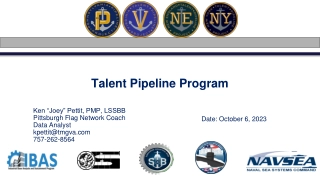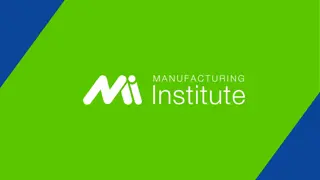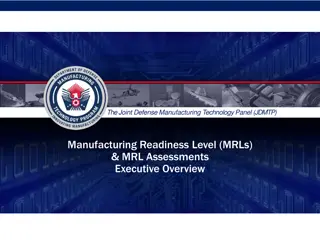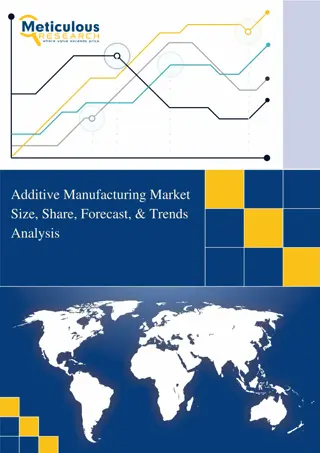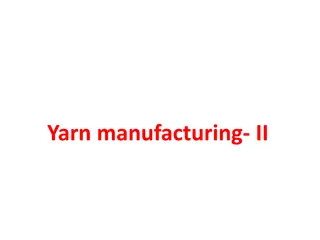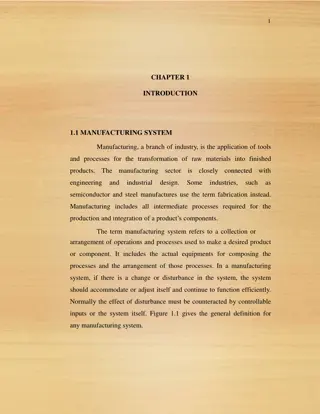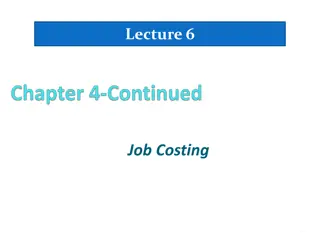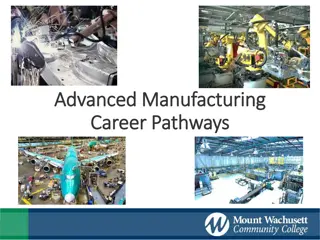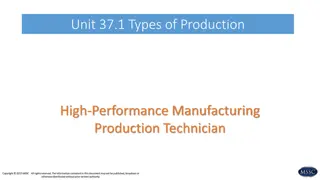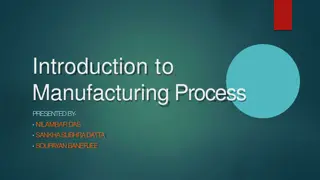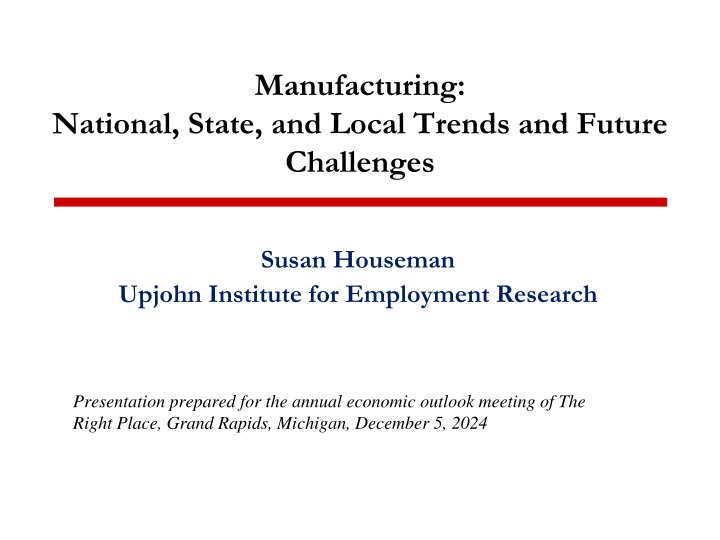
Challenges and Trends in Manufacturing Sector: Insights from Susan Houseman Presentation
Explore the historical context, trends, and future challenges in the manufacturing sector as highlighted in Susan Houseman's presentation. The decline in manufacturing employment, impact of automation on job losses, and the role of the computer/electronic products industry are discussed, shedding light on the complexities of the manufacturing landscape.
Download Presentation

Please find below an Image/Link to download the presentation.
The content on the website is provided AS IS for your information and personal use only. It may not be sold, licensed, or shared on other websites without obtaining consent from the author. If you encounter any issues during the download, it is possible that the publisher has removed the file from their server.
You are allowed to download the files provided on this website for personal or commercial use, subject to the condition that they are used lawfully. All files are the property of their respective owners.
The content on the website is provided AS IS for your information and personal use only. It may not be sold, licensed, or shared on other websites without obtaining consent from the author.
E N D
Presentation Transcript
Manufacturing: National, State, and Local Trends and Future Challenges Susan Houseman Upjohn Institute for Employment Research Presentation prepared for the annual economic outlook meeting of The Right Place, Grand Rapids, Michigan, December 5, 2024
Outline Historical context: The decline of manufacturing employment in the 21stCentury Trends in manufacturing: Grand Rapids MSA, the state, and the country Future challenges
Precipitous and unprecedented decline in U.S. manufacturing employment in 2000s Manufacturing Employment, 1947-2023 20 19 18 17 16 Emp, millions 15 14 13 12 11 10 2003 2005 2007 2009 2023 2001 2021 1951 1961 1971 1981 1991 2011 1947 1949 1953 1955 1957 1959 1963 1965 1967 1969 1973 1975 1977 1979 1983 1985 1987 1989 1993 1995 1997 1999 2013 2015 2017 2019 2000-2007 (both business cycle peaks) manufacturing lost 3.4 m. jobs, 20% of employment base Hard hit again in Great Recession. Although some recovery, mfg employment down about 4.3 m. jobs, or 25% since 2000.
Prevailing narrative at the time U.S. manufacturing sector is healthy proponents pointed to robust output growth and strong productivity numbers Job losses largely caused by productivity in the form of automation Workers simply victims of their own success Real GDP: Manufacturing and Private Industry 350 300 Real GDP Index, 1977=100 250 200 150 100 50 0 Private industries, real GDP Manufacturing, real GDP
But one industrycomputer & electronic products driving apparent robust output and productivity growth Real GDP, Private Industry and Manufacturing, without Computer Industry 350 300 250 Index, 1977=100 200 150 100 50 0 Private industries, less computers Manufacturing, less computers Without computer industry, mfg GDP growth 45% of private sector GDP growth, 1979-2000; 24% from 2000-2019 Mfg productivity no higher than aggregate productivity w/o computer industry
What was happening in computer/semiconductor industries? Accounts for <15% of manufacturing GDP Extraordinary real output and productivity growth reflects statistical adjustment for rapid advances in product quality in computers and semiconductors o In computer and electronic products and by extension all manufacturing robust growth resulted from product not process improvements Despite driving apparent robust domestic manufacturing output growth, locus of production shifting to Asia throughout the period
Causes of decline in manufacturing employment Now widely acknowledged that trade played a large role in manufacturing s precipitous employment decline in 2000s No surprise that we ve seen a political swing toward protectionism o Manufacturing employment collapse in early 2000s was economically destabilizing in many regions in the country. Supply chain disruptions during pandemic underscored U.S. vulnerabilities to trade and reinforced protectionist sentiments
Growing consensus on importance of a healthy manufacturing sector Strong manufacturing sector needed for national security U.S. also needs a healthy manufacturing sector to sustain innovation and a healthy economy o Manufacturing and R&D often need to be co-located o Loss of manufacturing ecosystem is undermining ability of country to innovate (MIT, university initiative, 2013) All too often in the past the United States squandered its leadership in a given technology area by moving manufacturing offshore; beginning with manufacturing, international competitors then gradually assumed control of the entire technology area. (National Academies of Sciences, Engineering, and Medicine, Options for a National Plan for Smart Manufacturing, 2024)
Trends in manufacturing: Grand Rapids MSA, the state, and the country
Grand Rapids MSA heavily reliant on manufacturing employment Manufacturing's Share of Nonfarm Payroll Employment, 2024 Grand Rapids 19.0% Michigan 13.4% United States 8.2% 0.0% 5.0% 10.0% 15.0% 20.0% Source: Bureau of Labor Statistics
Manufacturing performance since 2000 better overall in Grand Rapids than in country and state Manufacturing Employment, Index (Year 2000 = 100) 110 100 Grand Rapids 90 80 U.S. 70 60 Michigan 50 Source: Bureau of Labor Statistics
Since 2007 employment growth in the Grand Rapids areas leading manufacturing industries generally better than that in state and country Percent Change in Employment by Industry, 2007-2023 70 60 56.4 50 40 34.8 30 26.2 23.4 17.5 20 16.3 10 6.2 3.6 2.9 2.4 0 -1.0 -2.5 -4.9 -10 -6.3 -7.3 -7.3 -8.5 -10.7 -13.9 -20 -19.8 -30 -32.6 -40 Transportation Machinery Food Fabricated Metal Furniture Plastics and Rubber Computer and Electronic Products United States Michigan Grand Rapids Sources: Bureau of Labor Statistics and Lightcast
The Grand Rapids areas success Manufacturing-intensive regional economies usually fared poorly in the 2000s. Grand Rapids is perhaps the most successful manufacturing-oriented area in the United States. (Timothy Bartik, OECD presentation) Studies point to economic development strategies to retain and attract manufacturers for this success: o Improving job training programs o Helping find local buyers for family-owned manufacturing o Developing manufacturing industry clusters that can work together to identify solutions to common problems (Atkins et al. 2011, Bartik 2018)
Adoption of smart manufacturing technologies and practices necessary to be internationally competitive Smart manufacturing technologies and practices o Involve using networked data to increase productivity and precision, reduce waste, better manage resources o Network data on the plant, supply chain, customer demand Tools: Big data, cloud computing, cybersecurity, AI and machine learning, robotics, augmented & virtual reality, etc. Adoption especially challenging for small and medium manufacturers Barriers to adopting smart manufacturing o Cybersecurity threats o Vertically integrated business model and legacy software often incompatible with implementation of new technologies o Need to (re)train workforce at all levels
Smart manufacturing defines a journey of change in the workforce (National Academies 2024) Manual, repetitive, and high-precision tasks will be replaced by automated or autonomous operations. Machine-human interactions will allow workers to take on tasks of greater creativity, complexity, and innovation. New job roles will emerge, and many existing manufacturing roles in production, engineering, quality, and leadership will require new competencies.
Recruiting workforce seen as a #1 bottleneck to adopting smart manufacturing policies Survey of manufacturing companies: #1 challenge encountered while pursuing a smart manufacturing strategy is a lack of skilled talent (CESMII and SME, 2022) U.S. manufacturers have reported difficulty attracting qualified workers for at least a decade even without added skills requirements of smart manufacturing. (Annual surveys by Manufacturing Institute and Deloitte) Since 1990s, manufacturers in U.S. have increasingly relied on staffing industry to recruit and fill positions in factories Now account for an estimated 10% of core production jobs Staffing workers tend to fill lower-skilled positions inside factories Future role of staffing industry in supplying workers unclear with greater skill needs inherent in smart manufacturing o o
Challenge: Attracting workers to manufacturing careers Following steep employment declines in early 2000s, manufacturing often not seen as offering good career options o Relative wages among production workers fell o High schools reduced CTE programs that helped prepare students for jobs in manufacturing after graduation o Leading engineering programs report lack of interest in manufacturing education among students Misperceptions about manufacturing jobs today need to be addressed o Many advocate for greater exposure to manufacturing careers in middle and high school
Challenge: Meeting skills education and training needs for entry-level workers Community colleges primarily handle sub-baccalaureate, entry-level education and training Hands-on learning an important component, but o Equipment for educational labs is expensive o Often donated by companies, but donated equipment may be outdated Need to develop stacked credentials o Students often cannot attend college full-time or for prolonged periods o On and off ramps need to be built into credentialing (AMP Lab in Grand Rapids offers good example of this approach) Hiring and retaining qualified instructors difficult o Shortage of instructors o Private sector typically pays more
Challenge: Meeting education and training needs of incumbent workers Transition to smart manufacturing requires companies to provide incumbent workers new skills Rapid developments in technologies will require manufacturers to frequently update workers skills Upskilling workforce tends to be most difficult for small- and medium-sized manufacturers, who lack human resources and knowledge to provide training internally
Challenge: Meeting education and training needs of B.S., M.S., and Ph.D students Responsibility of 4-year colleges and universities: o Need to revamp manufacturing education to prepare students for smart manufacturing environments o Curricula need to be more interdisciplinary include training in different types of engineering, data science, IT, business o Like community colleges, 4-year institutions sometimes have difficulty attracting and retaining faculty specializing in manufacturing education
Challenge: Training the Trainer Shortage of skilled manufacturing workforce linked to shortage of faculty and instructors who can educate or train them o 4-year colleges and universities primarily responsible for the education of faculty and instructors Like workers, faculty and instructors need to keep abreast of developments in smart manufacturing o On-line resources are being developed o Hands-on experience in manufacturing facilities also important Collaborations between educational institutions and manufacturing companies will be more important in the future o One proposal: funding sabbaticals for professors and instructors to train with the latest smart manufacturing technologies in companies
Problem: Fragmented education and training system Much good work being done by Manufacturing USA institutes, SME, colleges and universities, and others around the country to advance training and education in smart manufacturing. However: Smart manufacturing is fast-moving, and existing efforts to train and educate the workforce are fragmented, insufficient, and slow. (National Academies, 2024) Community colleges, colleges and universities, and companies often left to develop curricula for educating or upskilling workers. This is inefficient and frequently leads to o Duplication of effort o Suboptimal results
Need for coordination at national level on smart manufacturing education and training Establish standards for credentials and support accreditation of programs in smart manufacturing Inventory curricula available to address smart manufacturing education and training needs o Compare to industry needs for both general and customized skills and identify gaps o Rigorously evaluate programs identify ones that work Forecast future needs for smart manufacturing education and training

